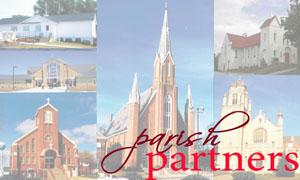
By Celine Klosterman
This weekend, parishes will begin what the Diocesan Planning Commission describes as the “dating” phase of their eventual long-term relationships.
Pastors or parish life administrators and two lay representatives from all 80 parishes in the Davenport Diocese will meet to determine which parishes they’ll collaborate with as members of a Local Area Planning Committee. By May 31, those committees should form a preliminary plan for how their parishes will work together to meet area Catholics’ needs over the next 10 years with fewer priests.
By 2020, more than twice as many priests in parish ministry will reach the retirement age of 70 as will be ordained, the Diocesan Planning Commission projects.
The commission has grouped parishes into 20 Local Area Planning Committees based largely on parishes’ recommendations, but the groupings aren’t set in stone, said Father Jim Vrba, commission co-chair. At the upcoming regional meetings, parish representatives may agree on different arrangements.
“The whole gist of these meetings is to encourage parishes — once they’ve figured out whom to work with — to start collaborating soon. If there’s going to be a marriage, you need to start dating,” Fr. Vrba said, quoting Mark Mogilka, director of stewardship and pastoral services for the Diocese of Green Bay, Wis., who has advised the commission.
Before attending a regional meeting Feb. 27, Feb. 28 or March 3, each parish representative is encouraged to read neighboring parishes’ self-evaluations of strengths and weaknesses and preferences for collaboration. The reports are available online at www.davenportdiocese.org/planning.
A representative of Sacred Heart Cathedral in Davenport, Rita Cunningham found the reports of nearby parishes helpful. She suggested that St. Paul the Apostle Parish in Davenport, which identified itself as having strong stewardship, might be able to advise Sacred Heart as the cathedral parish expands its stewardship efforts.
Cunningham also was inspired by reading that Our Lady of Victory Parish in Davenport publishes a quarterly newsletter. Creating a newsletter for all parishes on a Local Area Planning Committee might be a way to unify and communicate easily with all of them, she said.
Some parishes have already begun collaborating more in response to the planning process. In early January, St. Alphonsus Parish in Mount Pleasant and the nearby cluster parishes of St. John in Houghton and St. James in St. Paul changed their Mass schedules so a priest at one of those parishes can celebrate Mass for the neighboring pastor in case of an illness or vacation.
Change can be difficult, but worthwhile, noted Glenn Steffensmeier, a representative of St. John’s. “We’re all in this together.”
Lori Crock, a representative of St. Mary Parish in Mechanicsville, said she looks forward to the opportunity to meet and work with new people. She thinks inter-parish collaboration may make Catholics more comfortable attending Masses and events at multiple parishes — thus giving them more opportunities to grow in faith and connect with fellow Catholics.
“We’ve been spoiled at St. Mary’s; we’ve always had a priest,” she said.
Cluster parishes such as St. Patrick in Brooklyn and St. Bridget in Victor, which have shared a pastor for years, have valuable experience in working together, said Mary Jo Seaton, a representative of St. Patrick Parish in Brooklyn. But every parish has a different strength to contribute toward building a larger, stronger community, she said.
Challenges to the Catholic community are nothing new, she noted. “I look back and think about what my grandparents were faced with.” They started parishes and built churches by hand. “They didn’t give up. Their faith carried them on. That’s what’s going to keep me going … I’m praying we can all come together to have a better understanding and appreciation of each other.”
Upcoming regional meetings
As the first step in Phase III of the parish planning process, pastors, parish life administrators and two lay representatives from each parish will attend one of the following meetings for their area.
The Diocesan Planning Commission has informed pastors and parish life administrators about which meeting their parish should attend.
• Sunday, Feb. 27, 2-4 p.m., Bettendorf, Our Lady of Lourdes Church gathering space
• Sunday, Feb. 27, 6:30-8:30 p.m., Solon, St. Mary Parish Hall
• Monday, Feb. 28, 6:30-8:30 p.m., Oskaloosa, St. Mary Parish Hall
• Thursday, March 3, 6:30-8:30 p.m., Mount Pleasant, St. Alphonsus Parish Hall
At the meetings, parish representatives will form Local Area Planning Committees and receive guidelines for and an explanation of Phase III and Phase IV of the planning process. Details on the number of priests per deanery or area will be shared.
Parish planning process timeline
Phase III: Feb. 27 to May 31
Part A: Regional meetings held.
Part B: Local Area Planning Committees meet to develop preliminary plans to recommend to the bishop.
Phase IV: June 1 to Aug. 31
Eighty parishes hold separate parish meetings (town hall style) to review the preliminary plan developed by their Local Area Planning Committee. Parish leadership is consulted. Parishes decide to accept, reject and start over, or modify and accept. Brief status report is due July 15.
Phase V: Sept. 1-15
Local Area Planning Committee forwards recommended plans to Diocesan Planning Commission for review.
Phase VI: Sept. 15 to Oct. 1
Diocesan Planning Commission forwards Local Area Planning Committee-recommended plan to Presbyteral and Diocesan Pastoral Councils for review.
Oct. 1 to Dec. 1
Diocesan Planning Commission works to resolve differences and assist those areas that rejected and started over or are working on modifications.
Phase VII: Advent 2011
Bishop acknowledges plan. Commission reviews plan continuously, assists in implementation, completes ongoing evaluation as necessary.
For documents and more information on the planning process, visit www.davenportdiocese.org/planning.








